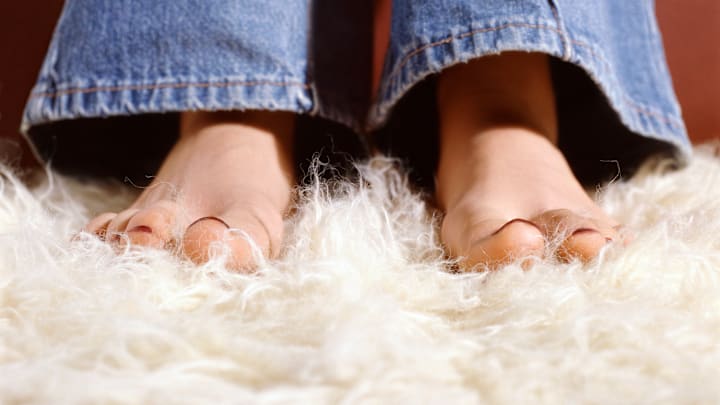In the 1970s, residents of San Bernardino, California, could rent a “deluxe” one-bedroom apartment at the Casa Royale complex for $130 a month. Among the amenities: being on the bus line, “lots of closets,” and “shag carpet.”
Shag carpeting certainly would not be something a landlord would advertise today, but for a period in the 1960s and 1970s, it was considered the ultimate in luxury flooring. Tall tufts of synthetic or natural fabrics were viewed as a status symbol—a way to say: yes, we’re doing well enough to afford all this yarn. But by the 1980s, shag carpeting was being hauled to the curb. So what happened?
How Shag Carpet Took Over Living Rooms

Shag carpeting actually predates the mid-20th century aesthetic by centuries. Ancient Greeks as well as cultures in the Middle East and Asia all had variations on what would later become known as a shag, using goat or other animal hair to create a plush rug. Greeks called them “flokati” rugs, though the word shag to mean a knotty or matted type of rug was used as early as the 1600s. These creations were part practical—they kept floors warm—and part artistic expression.
This genre of rug never really went away, but its mass-market appeal didn’t become possible until the late 1940s. That’s when American homes experienced a postwar building boom.
You May Also Like:
- Why Popcorn Ceilings Used to Be Popular—and Why They Vanished
- 20 Amazing IKEA Hacks You Should Try
- Why Did So Many Movie Theaters Have Funky Carpets in the 1990s?
Add Mental Floss as a preferred news source!
“The post-World War II era saw a surge in carpet sales that was primarily due to increased interest in home décor and new carpet fiber technologies,” flooring expert Emily Morrow told Retro Renovation. “Carpet had been a luxury during the war—as many home goods had been— and once the war was over, there were plenty of stay-at-home moms that were ready to decorate their homes with products they couldn’t get during the war years.”
Among the innovations was wall-to-wall carpeting. Instead of expensive fibers, carpeting could be woven using cheaper synthetic materials, such as nylon made to resemble wool. And instead of being relegated to area rugs, it was now feasible to install carpeting that could cover an entire floor. According to Cleaning and Restoration Magazine, six million square yards of carpet were shipped in 1951. By 1968, the number was nearly 400 million square yards.
This type of carpeting was initially smoother in appearance—the kind of close-cut carpet that shows vacuum cleaner impressions. But as the 1950s progressed, more and more styles of carpet became available. That led to experimentation, and that experimentation led to some bolder choices. Like shag.

The deep, unkempt fibers were a good fit for contemporary attitudes toward home decorating. Modern manufacturing and dye processes made it possible to opt for, say, orange shag to complement orange kitchen cabinets. This may seem like a bold choice now, but at the time there was a Technicolor attitude toward style.
Part of shag’s appeal may have also been psychological. “There’s a sort of turning inward in the home, almost these womb-like spaces that you can see in some of the furnishings and objects that are starting to happen,” Sarah Lichtman, an associate professor of design history at Parsons School of Design, told Apartment Therapy. “I think shag carpeting is part of that softness that was coming into the interior.”
Shag had practical benefits as well. Thanks to its deep tufts, it acts as a terrific flooring insulator, trapping warm air in rooms. It also has sound-dampening effects.
In the late 1960s and 1970s, shag become more affordable, and thus more pervasive. One company, Royalweve, offered Shagrila, a synthetic shag that promised to cost one-third less than traditional shag. It was “the latest and most dramatic answer to the great demand of homeowners all over the United States for the deep, tousled, luxurious informality of modern shag carpets.”
That demand, however, was soon to be on the wane.
The Fall of Shag Carpet
Two major factors conspired against shag carpeting in the latter quarter of the 20th century.
For one, it was frequently dirty. Because of the long tufts, dirt and debris was often trapped deep in the carpet and beyond the reach of vacuums. That’s why colors like avocado green or brown were preferred over white: They hid dirt better. Shag enthusiasts often took a special carpet rake to the fibers to loosen grime. It acted as a kind of grooming tool, restoring a carpet’s fluff. (Others just used an actual garden rake.) Ultimately it was an additional chore that homeowners grew to find tedious.
The Other Shag |
|---|
Shag is often used as a slang term for copulation, but despite the reputation of the swinging 1960s and the sexual revolution, there’s no seeming connection between shag and shag carpeting. Shag as a verb to describe sexual relations was used as early as the 1700s, while shag carpeting likely takes its name from the earlier use of the word to describe animal hair. |
But shag was doomed for another reason: conformity. As real estate came to be viewed as an investment tool and more and more people began moving or downsizing in the 1980s, the idea of something as personal as green shag carpeting became an obstacle. Many homeowners looking to sell thought hardwood flooring had more wide appeal, and thus might make selling easier. That, coupled with changing tastes, took the U.S. firmly out of its Brady Bunch era of décor.
Does that mean shag is permanently exiled? Not exactly. Because trends are cyclical, plenty of people embrace the shag aesthetic today, though mostly in area rugs to give rooms a certain retro lift. And because they’re more of an accent, dirt is less of a concern. Shag endures, just not wall to wall.
